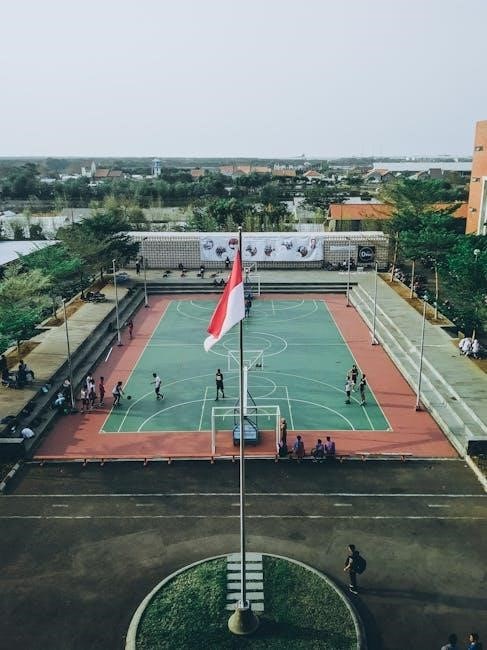High school weight training programs focus on improving muscular strength, endurance, and functional fitness through structured routines, emphasizing safety, proper techniques, and personalized goals for student-athletes.
1.1 Importance of Weight Training for High School Athletes
Weight training enhances athletic performance, boosts muscular strength, and improves endurance, reducing injury risk. It fosters functional strength, enabling athletes to excel in sports while promoting overall physical and mental well-being. Properly designed programs ensure safe, effective progression for high school students.
1.2 Overview of a High School Weight Training Program Structure
A high school weight training program typically includes phases like accumulation and intensification, focusing on compound exercises. It often follows a split routine, such as a 4-day program for football players or a 3-day split for multi-sport athletes, emphasizing core strength, proper form, and progressive overload, with adjustments based on athlete needs and performance tracking.

Safety and Injury Prevention
Safety protocols and injury prevention are critical in high school weight training. Proper equipment, spotting techniques, and weight room etiquette ensure a secure environment for all athletes.
2.1 Essential Safety Equipment and Spotting Techniques
Essential safety equipment includes weight racks, safety collars, and spotting platforms. Proper spotting techniques, such as active spotting and safety protocols, ensure athlete well-being. Weight room rules like returning equipment and using spotters prevent accidents, fostering a secure training environment for all participants.
2.2 Weight Room Etiquette and Expectations
Weight room etiquette includes understanding safety signals, using spotters, and returning equipment to its place. Sharing equipment, respecting others, and maintaining a clean environment are key expectations. These practices ensure a safe, orderly, and productive workout atmosphere for all participants, promoting responsibility and teamwork among athletes.
Program Design and Phases
High school weight training programs are structured in phases, starting with accumulation to build strength and size, followed by intensification to enhance power and performance effectively.
3.1 Accumulation Phase: Building Strength and Size
The accumulation phase focuses on increasing muscle mass and overall strength through higher volume and moderate intensity. Athletes perform multiple sets with controlled reps, targeting major muscle groups. This phase lays the foundation for future performance by enhancing muscular endurance and hypertrophy, preparing the body for more intense training in subsequent phases effectively.
3.2 Intensification Phase: Increasing Power and Performance
The intensification phase shifts focus to enhancing power and performance by incorporating explosive movements and advanced techniques. Cluster sets, plyometric exercises, and dynamic efforts are emphasized to maximize power output. This phase bridges the gap between strength gains and operational sport performance, ensuring athletes can apply their strength effectively in competitive scenarios while maintaining proper form and safety standards.
Benefits of Weight Training for High School Students
Weight training enhances muscular strength, endurance, and functional fitness, while promoting injury prevention and improving overall athletic performance for high school students.
4.1 Improving Muscular Strength and Endurance
Weight training enhances muscular strength and endurance by targeting specific muscle groups through resistance exercises, promoting progressive overload, and improving overall athletic performance for high school students.
4.2 Injury Prevention and Functional Strength
Weight training helps high school athletes prevent injuries by improving joint stability, muscle balance, and overall functional strength. Strengthening key muscle groups reduces the risk of common sports injuries, while enhancing durability and resilience for long-term athletic performance.
Choosing the Right Exercises
Selecting exercises tailored to athletic goals and fitness levels ensures effective strength development, focusing on compound movements and functional exercises to enhance overall performance in high school athletes.
5.1 Free Weights vs. Machine-Based Exercises
Free weights, such as barbells and dumbbells, enhance functional strength and muscle engagement, requiring more effort and control. Machine-based exercises provide stability and safety, ideal for beginners or isolating specific muscles. Both tools are valuable, but free weights are often preferred for building real-world strength and athleticism in high school training programs.
5.2 Core and Compound Exercises for High School Athletes
Core exercises like planks, Russian twists, and leg raises improve stability and balance, essential for athletic performance. Compound exercises such as deadlifts, squats, bench presses, and pull-ups target multiple muscle groups, enhancing overall strength and functional movement. These exercises are foundational in high school weight training programs to build well-rounded athleticism and prepare for sports-specific demands.
Progress Tracking and Periodization
Progress tracking involves monitoring strength gains and adjusting training phases to ensure optimal development. Periodization ensures structured, varied training cycles for long-term success.
6.1 Monitoring Progress and Adjusting the Program
Regularly tracking progress through strength assessments ensures workouts remain effective. Adjustments to the program are made based on individual performance, allowing for personalized growth and preventing plateaus.
6.2 Periodization Strategies for Long-Term Success
Periodization involves structuring training into phases to optimize performance and prevent plateaus. By alternating between accumulation and intensification phases, athletes achieve progressive overload, enhancing strength and power. This cyclical approach ensures sustained progress, reduces injury risk, and aligns with seasonal goals, making it essential for long-term athletic development.
Nutrition and Recovery
Nutrition and recovery are critical for optimal performance in high school weight training. A balanced diet, proper hydration, and adequate protein intake support muscle growth and repair.
7.1 Role of Nutrition in Supporting Weight Training
Nutrition plays a vital role in high school weight training, providing the necessary fuel for muscle growth and recovery. A balanced diet rich in proteins, carbohydrates, and healthy fats helps athletes optimize performance, build strength, and sustain energy levels during intense workouts. Proper hydration is also essential to maintain physical function and overall health.
7.2 Recovery Techniques for Optimal Performance
Recovery is crucial for high school athletes to optimize performance and prevent overtraining. Techniques include stretching, foam rolling, and hydration to reduce muscle soreness. Adequate sleep and rest days allow muscles to repair and strengthen. Active recovery, such as light cardio or yoga, promotes blood flow and flexibility, ensuring athletes return to training refreshed and ready to perform at their best.
Power Development and Plyometric Training
Plyometric training enhances explosive power and speed, essential for high school athletes. Techniques like jump squats and box jumps improve muscular reactivity, boosting performance in sports.
8.1 Incorporating Plyometrics into the Program
Plyometric training is essential for developing explosive power in high school athletes. Exercises like jump squats, box jumps, and burpees improve muscular reactivity and speed. Proper technique and progression are critical to ensure safety and maximize performance. Plyometrics should be integrated into the program 2-3 times per week, focusing on lower body movements to enhance sport-specific explosiveness and agility.
8.2 Accelerated and Assisted Plyometric Programming
Accelerated and assisted plyometric techniques, such as depth jumps and resisted jumps, enhance power and speed. These methods use external loads or elevated surfaces to amplify explosive force. Athletes progress gradually, ensuring proper form and safety. Assisted plyometrics, like band-assisted jump squats, reduce injury risk while building strength and reactivity, making them ideal for advanced high school athletes seeking peak performance.

Core and Neck Training
Core and neck training enhances stability, posture, and overall athletic performance. Exercises like planks, Russian twists, and neck bridges target these areas, improving strength and reducing injury risks.
9.1 Importance of Core Strength for Athletes
Core strength is vital for athletes as it enhances stability, balance, and overall performance. A strong core improves power transfer between upper and lower body, reducing injury risk and boosting endurance. It supports proper posture and movement efficiency, making it essential for all sports. Incorporating exercises like planks and Russian twists can significantly benefit athletes.
9.2 Effective Neck Training Exercises and Techniques
Neck training is crucial for athletes to improve stability, reduce injury risk, and enhance overall performance. Effective exercises include neck bridges, resistance band work, and isometric holds. Proper form and gradual progression are essential to avoid strain. Strengthening the neck muscles contributes to better posture and durability, especially in contact sports, making it a key component of a well-rounded training program.

Sample Workout Schedules
Sample workout schedules include 4-day splits for football players and 3-day splits for multi-sport athletes, focusing on compound exercises, progressive overload, and recovery techniques.
10.1 4-Day Split for Football Players
A 4-day split focuses on building strength and power, with each day targeting specific muscle groups. Day 1: Lower body (squats, deadlifts), Day 2: Upper body (bench press, pull-ups), Day 3: Core and plyometrics, Day 4: Active recovery and mobility. This structure ensures balanced development while allowing adequate recovery time between sessions;
- Each workout includes compound exercises like squats and bench presses.
- Progressive overload is emphasized to increase strength and power.
- Core and plyometric training enhance functional strength and explosiveness.
- Active recovery on Day 4 promotes muscle repair and flexibility.
This program is designed to improve football-specific performance while reducing injury risk through structured, sport-specific training.
10.2 3-Day Split for Multi-Sport Athletes
A 3-day split is ideal for multi-sport athletes, focusing on overall strength, endurance, and flexibility. Day 1 targets upper body and core, Day 2 emphasizes lower body and power, and Day 3 focuses on active recovery and mobility. This balanced approach supports versatility across multiple sports while promoting injury prevention and functional strength.
- Includes compound exercises like bench presses and squats for full-body engagement.
- Progressive overload and plyometric drills enhance power and explosiveness.
- Active recovery incorporates light cardio and stretching for optimal muscle repair.
- Customizable to accommodate sport-specific demands and athlete needs.
This program ensures athletes maintain peak performance across multiple sports seasons.
Year-Round Strength and Conditioning Programs
Year-round programs ensure continuous development of strength, power, and endurance, with district-wide initiatives and school-specific plans fostering collaboration between coaches and athletes for sustained success.
11.1 District-Wide Initiatives and School Programs
District-wide strength and conditioning programs ensure consistency and accessibility across schools. These initiatives include standardized training methods, safety protocols, and resource allocation. Many schools adopt year-round programs, such as Vertus High School’s donation-funded initiative, emphasizing collaboration between coaches and athletes. Programs like Guyer High School’s focus on free weights and barbell exercises, promoting functional strength and teamwork.
11.2 Collaboration Between Coaches and Athletes
Effective collaboration between coaches and athletes is crucial for successful weight training programs. Coaches design personalized plans, communicate goals, and provide feedback, while athletes commit to consistent effort. Open communication ensures shared accountability, fostering trust and motivation. Examples like Cherry Creek High School’s initiatives highlight the importance of this partnership in achieving athletic success and overall development.
High school weight training programs effectively enhance strength, endurance, and athletic performance while fostering a culture of safety and dedication, empowering students for long-term success.
12.1 Final Thoughts on Designing a High School Weight Training Program
Designing a high school weight training program requires a balanced approach, focusing on safety, proper techniques, and personalized goals. Coaches and athletes must collaborate to ensure programs are effective, engaging, and tailored to individual needs, fostering long-term success and a lifelong commitment to fitness and athletic excellence.
12.2 Resources for Further Learning and Program Development
Coaches and athletes can access various resources, including PDF guides, manuals, and online courses, to enhance their knowledge and program design skills. These materials provide scientifically-backed training methods, exercise techniques, and program organization strategies, ensuring a well-rounded approach to high school weight training and long-term athletic development.

Additional Resources
Find comprehensive guides, PDF manuals, and online courses offering detailed training methods, exercise techniques, and program design strategies for high school weight training programs.
13.1 Recommended PDF Guides and Manuals
Explore top-rated PDF guides like the Triphasic Training Manual and NSCA’s Strength Training for Athletes. These resources offer detailed workout plans, safety protocols, and nutrition advice tailored for high school athletes. They cover program design, periodization, and plyometric exercises, ensuring a well-rounded approach to weight training. These manuals are essential for coaches and athletes seeking evidence-based, practical strategies for success.
13.2 Online Courses and Videos for Coaches and Athletes
Enhance your knowledge with online courses from platforms like Coursera, YouTube, and Udemy. Videos and tutorials cover weight training fundamentals, plyometric exercises, and program design. Resources like XL Athlete and NSCA offer expert-led sessions, providing practical insights and demonstrations. These tools help coaches and athletes refine techniques, ensuring safe and effective training tailored to high school programs.
